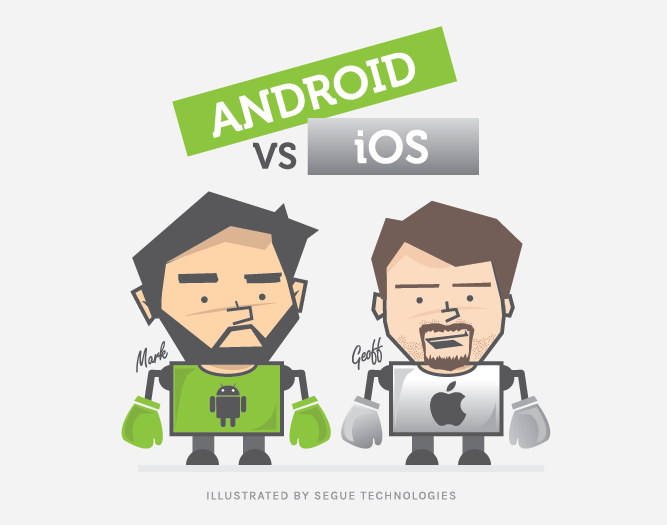One of the questions we at Segue are often asked by our customers is, “Which platform should I build for first, Android or iOS?” There are many different aspects to consider when answering this question. To answer it fully, we’ve brought together two of our mobile application developers: Geoff Bender, our lead iOS developer and Mark R. Andrachek, Jr., our lead Android Developer.

In round one of this series, we discussed the issue of market share. In the second round of our discussion, the experts will discuss the different software and hardware features that iOS and Android provide, respectively.
Round Two: Software and Hardware Options
Mark Andrachek, Lead Android Developer: Because of Android’s popularity there are many Android devices out there — phones, tablets, and wearables — in just about every size and price point imaginable. This is possible due to the open nature of Android. It is built on Open Source Software, including the Linux kernel, and is itself largely available under the Apache 2 license.
That open source nature has made Android the de-facto choice for companies and users looking for customizability and flexibility. You have third party app stores, like Amazon, F-droid, and the region specific markets like those in China. There are custom ROMs that replace the entire OS, third party launchers (home screen replacements), home screen widgets, theme and icon packs, and hardware with customized versions of Android like Amazon’s Kindle Fire, NextBit’s Robin, and SilentCircle’s Blackphone.
While this diversity can be a challenge from a support and testing perspective, it’s also one of the core strengths of Android. Competition between Android device manufacturers, not just iOS, has helped drive progress. Important bits, like fingerprint support for example — once requiring one-off manufacturer specific SDK’s — wind up baked into the core of the platform.
Geoff Bender, Lead iOS Developer: Well, many of the devices on the iOS side are similar. Apple controls both the software and the hardware so you don’t have quite the level of diversity between the devices and the features that each support. Since the iPhone 5, screen sizes of iOS phones and tablets have varied considerably. I think the bigger screen sizes on Android ended up being a pretty successful feature, so Apple decided to follow suit with that.
Unlike Android devices, Apple had not supported near field communication for mobile payments until the iPhone 6 came around. Now iPhone users can make mobile payments using any phone newer than the iPhone 6 or by using an iPhone 5, 5C, or 5S in combination with the Apple Watch, although the latter case does not support Touch ID.
I’d say the biggest difference between the two platforms is ultimately the ecosystem and how users organize their lives around their devices. Apple users tend to have iPods, iPhones, iPads, Macs… and all of the devices synch across iCloud. Charging adapters and earbuds can be shared between devices, software usability across devices is consistent, and as time progresses, feature parity between iOS and OS X has grown steadily. Because the hardware and software are created and controlled by Apple across each device, the experience is consistent across the entire ecosystem. Android users tend to use a whole suite of different services, mostly Google services, for organizing their lives but can potentially run into feature differences between various hardware manufacturers and OS versions.
Want more? Check out Round Three: Cost and Time.